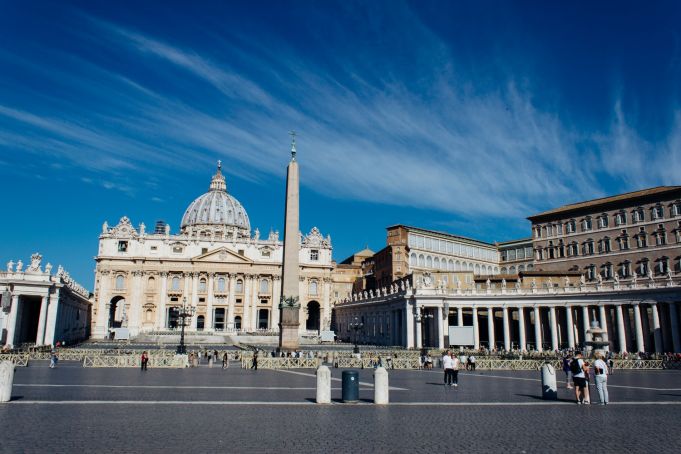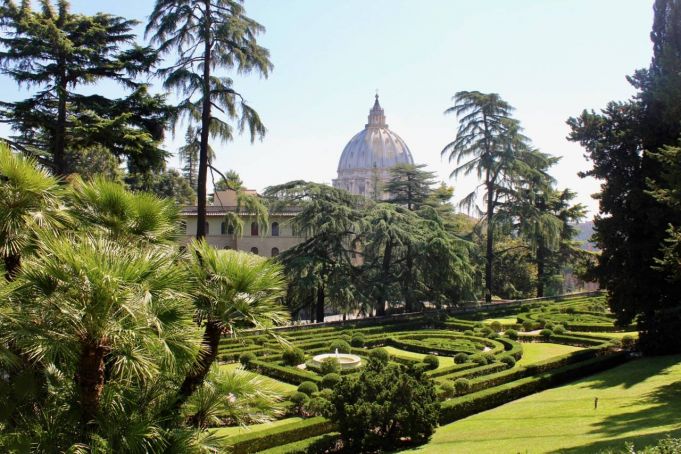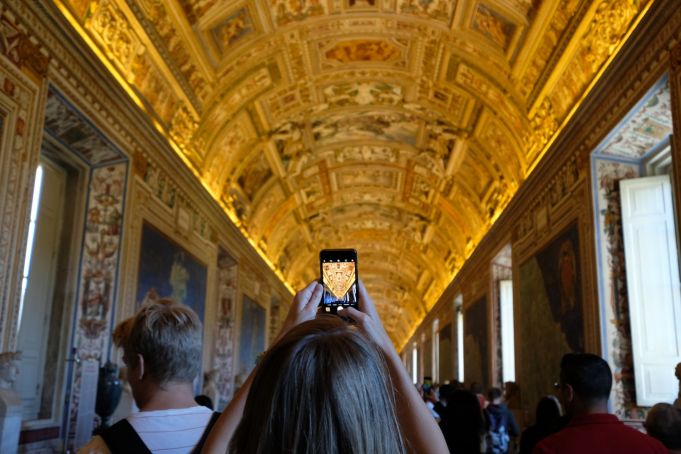The ultimate guide on how to visit the Vatican City, Vatican Gardens and Museums along with practical information including tickets and visiting hours.
For those who are planning a holiday in Rome, here is an itinerary of Vatican City. A visit to the smallest state in the world is absolutely worth doing at least once in a lifetime. From St Peter's Basilica, to the Vatican Gardens, from the Vatican Museums and the Sistine Chapel to the archaeological points, the beauty of the Vatican is unparalleled, and every corner is rich in art and history.Let’s start from the beginning: where exactly is the Vatican?
The Vatican is located near the Tiber river, in the heart of Rome. The whole area is surrounded by walls. If you want to stay in the area, but at reasonable prices, consider a hotel in the Prati neighborhood of Rome.St Peter’s Square and Basilica

Also read: How to buy tickets for the Vatican Museum
The interior of the Basilica contains a number of priceless artworks, such as the Pietà by Michelangelo (considered one of the most precious marble statues the world); a bronze statue of St Peter invites us to the dome, where above the papal altar we find the bronze canopy by Bernini.
In addition to St Peter's Basilica, there are many other churches within the Vatican that are worth visiting, perhaps with an organised tour.
The Vatican Gardens

The Gardens have been the resting place of the Roman Pontiff since 1279. Walking through the Italian or English gardens, you come across playful fountains, streams, temples and caves. Below the Basilica of St Peter, you can visit the necropolis, a Roman cemetery, which is the burial place of St Peter - the first pope. Also located in this area are Vatican Grottoes, which house the tombs of all the popes.
What to see in the Vatican Museums

The Egyptian and Etruscan Museums
Gregorian Egyptian Museum & Gregorian Etruscan Museum were both founded by Pope Gregory XVI in 1839 and 1837 to complete the collection of antiques of the Papal Museums and to give a wide overlook on this two civilisations so important for the development of the Mediterranean culture.The Pio Clementino Museum
The Pio Clementino Museum is the heart of the Antique sculpture collection of the Vatican, and one of the first buildings ever designed to be a Museum of Art. The foundation dates back to the papacies of Clement XIV (1769-1774) and Pius VI (1775-1799) but the original collection was housed at the famous Belvedere courtyard already in the Renaissance. Statues like the Laocoon, the Apollo del Belvedere and the Torso have been studied by generations and generations of artist and connoisseurs becoming paramount examples for the development of the canon of beauty into European Art.The Chiaramonti Museum
Chiaramonti Museum is named after Pope Pius VII Chiaramonti, and was opened in 1806 during the dramatic years of the conflict against Napoleon. Many art pieces were brought to France and even the pope himself, in 1809, was imprisoned by the French emperor. With Napoleon’s fall, Antonio Canova, the most famous sculptor of his time, was chosen for the recovery of all art taken away and to display it into this new hall. Around 1,000 pieces of antiques were finally exhibited with a special attention to the extraordinary collection of Roman portrait busts.The New wing was added to the Chiaramonti Gallery when all the art confiscated by the France found his way back to Rome. Architect Raffaele Stern conceived a building that had as its primary objective a better fruition of the works of art. The perfect natural lighting still helps to admire masterpieces like the Augustus of Prima Porta and the Giustiniani Athena.
Lapidary Gallery
Lapidary Gallery is displayed in the Ambulacrum Iulianum, a corridor built by Bramante in the 16th century for Pope Julius II and consisting of a countless collection of lapidary inscriptions. The section is normally closed to visitors.The Gregoriano Profano Museum
The Gregoriano Profano Museum was founded by Gregrory XVI in 1844 and hosts findings of the archaeological excavations of that period. Particularly interesting are some Imperial Roman age copies of Greek originals and the collection of funerary marbles.Lapidario Profano ex Lateranense
Lapidario Profano ex Lateranense comprises a collection of Roman inscriptions displayed at the Vatican Museums after being transferred from the papal palace at the Lateran in 1981.Pius-Christian Museum
Pius-Christian Museum was created by Pope Pius IX to house works of art of the early Christian age in Rome. Founded officially in 1854, the Museum became immediately the exhibition area of the art works excavated by the Pontifical Commission for Sacred Archeology established two years earlier. Along with the significant sarcophagi collection, worth a visit is the “iconic” Good Shepard statue.Christian Lapidarium and Jewish Lapidarium
Christian Lapidarium and Jewish Lapidarium are two collections of ancient inscriptions both transferred to the Vatican from their former home at the Lateran Palace. They represent a unique “marble stone library” of the early Christian and Jewish world in Rome.Pinacoteca
Pinacoteca literally a “chest for painted boards” is a word from the ancient Greek language and depicts perfectly this section of the Museum. More than 460 paintings distributed on chronologic basis recount the development of the Christian art of painting from middle ages until the 19th century. There are works of artists like Giotto, Fra Angelico, Perugino, Leonardo, Tiziano and obviously Raphael’s masterpieces such as, for example, his last piece, the Transfiguration and the fabulous tapestries documenting the lives of Peter and Paul.The Ethnological Museum
The Ethnological Museum of the Vatican draws its origins from a temporary exhibition organised by Pope Pius XI in 1925. The enormous and unexpected success of the event convinced the pope to make it permanent. The collection nowadays is amongst the most various and comprehensive of the world.The Carriage Pavilion
The Carriage Pavilion displays the history of papal mobility from the 16th century to modern times. Old luxury carriages are displayed together with the famous cars donated to popes in recent decades.The Christian Museum
The Christian Museum is distributed into the west galleries of the new Belvedere Courtyard, currently used as the way out corridor from the Sistine chapel to the exit of the Museum. The religious objects displayed are focused on the history of faith and culture from early Christianity to the modern Catholic world.The Profane Museum
The Profane Museum dates to 1761 and is one of the first collections ever opened to the public. It is located into the Clementine galleries and displays precious non-Christian manufacts as cameos, ivories and bronzes. The gem is undoubtedly the so-called Hall, a perfectly preserved “cabinet of antiquities” conceived for Pope Clement XIII for the inauguration of the museum.The Room of the Aldobrandini Wedding
The Room of the Aldobrandini Wedding takes his name from the famous Roman fresco once owned by the Aldobrandini family, one of the most influential paintings from the Roman empire. Other ancient frescoes and mosaic are surrounding it making of this room a nonpareil for Roman art lovers. From the room there is a spectacular view of St Peter's dome.The Chapel of St. Peter Martyr
The Chapel of St. Peter Martyr is located right in front of the Sistine Chapel exit. It was painted by Giorgio Vasari and his pupil Jacopo Zucchi around 1570.The Collection of Contemporary Art
The Collection of Contemporary Art was inaugurated by pope Paul VI in 1973 and consists now in around 8,000 works. It is partially located into the marvellous Renaissance apartment of Pope Borgia, giving to the viewer an extraordinary contrast of ancient and modern. It includes masterpieces of artists like van Gogh, Bacon, de Chirico, Chagall, Morandi and many others making this 20th-century art collection one of the most important in Italy.The Sistine Chapel
The Sistine Chapel is probably the most magnificent masterpiece of all Italian Renaissance and one of the most important art pieces of all European art. The chapel was built by pope Sixtius IV and still takes his name. He also commissioned the paintings with the stories of prophet Moses and Jesus, frescoed by artists like Botticelli, Perugino and Ghirlandaio in 1481-1482 on the side walls of the chapel. In the same place, but one generation later was Michelangelo, called in Rome by Pope Julius II, to be chosen for the commission of the ceiling decoration. The Tuscan artist, even if he was mainly a sculptor, created there a fresco painting considered by all his highest masterpiece: “la Volta” (the ceiling) represents the stories of the Genesis (1508-1512) surrounded by gigantic Prophets and Sybils. 25 years later Michelangelo worked again in the chapel, representing this time the end of the Christian history of Salvation: the Last Judgment, painted over the altar (1537-1541), on commission of pope Paul III.Raphael's Rooms
The so known Raphael's Rooms are the apartments of pope Julius II and his successors. Their current name comes from Raphaël, who decorated the four rooms (Hall of Constantine, Room of Heliodorus, Room of the Segnatura, Room of the Fire in the Borgo) between 1508 and 1524 together with his workshop. The project occupied most of his working life and marks a turning point in the history of High Renaissance. With Raphael art finally reached and overtook the unreachable quality of Antique art.The Borgia Apartment
The Borgia Apartment were decorated for the Spanish pope Alexander VI Borgia. This legendary pope, who sat on the throne of Peter the day of the discovery of America, is also famous as being probably the worst sinner to sit on that throne.The six spaces of the apartments are decorated by Pinturicchio (1492-1494) and his school and are the absolute apex of his art. Gilding Ancient Roman ornamental motifs, stories of saints and a surprising portrait of pope Alexander VI are detailed with proficiency skills into brilliant and jarring colors making the visit of those rooms a real must.
The Niccoline Chapel
The Niccoline Chapel owes his name to Pope Nicholas V and is fully decorated by fresco paintings done by Beato Angelico around 1448. The chapel is on the same level of the Raphael Rooms but is usually close to visitors.The Chapel of Urban VIII
The Chapel of Urban VIII is situated into the Renaissance apartments also if the room has become a private chapel only in 1631 upon request of Pope Urban VIII. The ceiling is fully decorated with stucco and frescoes depicting the Stories of the Passion of Christ, the two authors are Alessandro Viviani and Pietro da Cortona, while the walls are covered with precious ornated and stamped leather.The Room of the Immaculate Conception
The Room of the Immaculate Conception has been frescoed by Francesco Podesti to celebrate the proclamation of the dogma of the Immaculate Conception done by Pope Pius IX on December 8 1854. The beautiful paintings, narrating the theological aspects of the dogma are covering the four walls and the vault while on the floor was installed a Roman full colored mosaic originally coming from Ostia antica.The Room of the Chiaroscuri
The Room of the Chiaroscuri is located into the heart of the medieval palace. It has been decorated with a series of Apostles and Saints done by Raphael and strongly repainted few decades later by the Zuccari brothers. Notable is also the wooden coffered ceiling with a colossal coat of arm of Pope Leo X Medici, made following an original project by Raphael. The room is usually closed to visitors.Make a day of it
With the opening of the Pontifical Villas to the public in 2014, the Vatican Museums offer a ride on an electrical train to visit the Barberini Garden of Castel Gandolfo (24 km from Rome). This day trip is available on Saturdays only (€42).Practical info
Vatican Museum Visiting Hours: Mon-Sat 09.00-18.00 (latest entry 16.00.)St Peter’s Basilica Visiting Hours: April to September: 07.00-19.00 - October to March: 07.00-18.00.
Special Notes
Dressing for your visit: Trouserss and skirts must cover the knee and shoulders must be covered. We recommend keeping a shawl or large scarf in your bag, to put on before entering churches.Also read: A practical guide on how to dress for the Vatican
Watch out for scams: Be aware that there will be plenty of companies over-charging for tours just outside of the Vatican walls. In order to avoid scams, we recommend booking through the Vatican website in advance of your arrival.
Tickets
A ticket purchased for the Vatican Museum automatically grants access into the Sistine Chapel. Click here for all info on tickets to for the Vatican Museums.Also Read:
- Best day trips from Rome
- 29 Best Things To Do in Rome
- Top 10 beaches near Rome
- Visiting Castel Sant’Angelo, Rome's Castle
- Visiting the Roman Forum
- How to visit Galleria Borghese in Rome
- How to buy tickets for the Vatican Museum
- Hadrian's Villa in Tivoli
- All you need to know about Piazza Navona
- The Trevi Fountain: A Brief Histor
General Info
View on Map
Visiting the Vatican Museums: All You Need to Know
00120, Vatican City




















